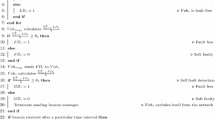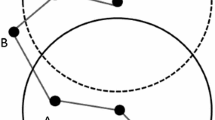Abstract
Built upon the fragile mobile devices and shared wireless channels, Vehicular Ad-Hoc Networks (VANETs) are vulnerable to misbehaving nodes. The critical problems that affect the serviceability of the entire network are maintaining an acceptable level of network performance degradation, and fair allocation of resource among different users in the presence of misbehaving nodes. This paper investigates the optimization problem via the joint design of rate control and multi-path routing in fault-aware VANETs. We use statistical information and estimation on each wireless link to characterize the effect of faults, and develop a leaky-path model. This model takes account of packet loss along fault-paths and the “shrinking” feature of effective flow at the destination node. Moreover, we use a cost function to measure the impact of fault-correlation among multi-routing paths on effective flows. Based on the leaky-path model and the cost function, a fault-correlated flow control and routing ((FC)2 R) approach is proposed to maximize the network utility associated with the effective rate. We design a novel distributed algorithm to adjust flow rates adaptively on each path, using multi-path routing. Our simulation results demonstrate that higher effective network throughput, and better fairness, can be achieved by our algorithm than the standard optimal flow control in the presence of misbehaving nodes.

















Similar content being viewed by others
References
Arrow KJ (1958) Studies in linear and nonlinear programming. Standford University Press, Uzawa H
Bari A, Jaekel A, Jiang J, Xu Y (2012) Design of fault tolerant wireless sensor networks satisfying survivability and lifetime requirements. Comput Commun 35(3):320–333
Challal Y, Ouadjaout A, Lasla N, Bagaa M, Hadjidj A (2011) Secure and efficient disjoint multipath construction for fault tolerant routing in wireless sensor networks. J Netw Comput Appl 34(4):1380–1397
Chen L, Leneutre J (2009) On multipath routing in multihop wireless networks: security, performance, and their tradeoff. EURASIP J Wirel Commun Netw. 2009
Du S, Li X, Du J, Zhu H (2012) An attack-and-defence game for security assessment in vehicular ad hoc networks. Peer-to-Peer Networking and Applications
Eiza MH, Ni Q, Owens T, Min G (2013) Investigation of routing reliability of vehicular ad hoc networks. EURASIP J Wirel Commun Netw:2013
Farnoud F, Valaee S (2009) Reliable broadcast of safety messages in vehicular Ad hoc networks. In: IEEE INFOCOM, pp 226–234
Gerla M, Kleinrock L (2011) Vehicular networks and the future of the mobile internet. Comput Netw 55(2):457–469
Gohari AA, Pakbaz R, Melliar-Smith PM, Moser LE, Rodoplu V (2011) RMR: Reliability map routing for tactical mobile ad hoc networks. IEEE J Sel Areas Commun 29(10):1935–1947
Gupta P, Kumar PR (2000) The capacity of wireless networks. IEEE Trans Inform Theory 46(2):388–404
He R, Rutagemwa H, Shen X (2008) Differentiated reliable routing in hybrid vehicular ad-hoc networks. In: IEEE ICC, pp 2353–2358
Hosseinabadi G, Vaidya N (2010) Selfish misbehavior in the optimal cross-layered rate control of wireless networks. Technical Report, CRHC, University of Illinois at Urbana-Champaign. http://www.crhc.illinois.edu/wireless/papers/tech-report-Ghazale-SelfishCrossLayered-March.pdf
Huang X, Fang Y (2009) Performance study of node-disjoint multipath routing in vehicular ad hoc networks. IEEE Trans Veh Technol 58(4):1942–1950
Jain R (1984) A quantitative measure of fairness and discrimination for resource allocation in shared computer systems. Techical Report, Hawe W
Jin J, Palaniswami M, Krishnamachari B (2012) Rate control for heterogeneous wireless sensor networks: Characterization, algorithm and performance. Comput Netw 56(2012):3783–3794
Karagiannis G, Altintas O, Ekici E et al (2011) Vehicular networking: a survey and tutorial on requirements, architectures, challenges, standards and solutions. IEEE Commun Surv Tutorials 13(4):584–616
Kelly FP (1997) Charging and rate control for elastic traffic. European Trans Telecommun 8:33–37
Kelly FP, Maulloo A, Tan D (1998) Rate control for communication networks: Shadow prices, proportional fairness and stability. J Oper Res Soc 49(3):237–252
Koksal CE, Balakrishnan H (2006) Quality-aware routing metrics for time-varying wireless mesh networks. IEEE J Sel Areas Commun 24(11):1984–1994
Li X, Cuthbert L (2004) On-demand node-disjoint multipath routing in wireless ad hoc networks. In: IEEE LCN, pp 419–420
Lee J, Chiang M, Calderbank AR (2007) Utility-optimal random-access control. IEEE Trans on Wireless Commun 6(7):2741– 2751
Mo J, Walrand J (2000) Fair end-to-end window-based congestion control. IEEE/ACM Trans Netw 8(5):556–567
Ng D WK, Lo ES, Schober R (2011) Secure resource allocation and scheduling for OFDMA decode-and-forward relay networks. IEEE Trans Wireless Commun 10(10):3528–3540
Ohara Y, Imahori S, Meter RV (2009) SMARA: Maximum alternative routing algorithm. In: IEEE INFOCOM, pp 298–306
Park SJ, Vedantham R, Sivakumar R, Akyildiz IF (2004) A scalable approach for reliable downstream data delivery in wireless networks. In: MobiHoc, pp 78–89
Rao L, Liu X, Kang K-D, Liu W, Liu L, Chen Y (2011) Optimal joint multi-path routing and sampling rates assignment for real-time wireless sensor networks. In: IEEE ICC, pp 1–5
Rivas DA, Barcelo-Ordinas JM, Zapata MG, Morillo-Pozo JD (2011) Security on VANETs: Privacy, misbehaving nodes, false information and secure data aggregation. J Netw Comput Appl 34(6):1942–1955
Rockafellar R, Wets R (1998) Variational analysis. Springer
Saad M, Leon-Garcia A, Yu W (2007) Optimal network rate allocation under end-to-end quality-of-service requirements. IEEE Trans Netw Serv Manag 4(3):40–49
Su H, Zhang X (2007) Clustering-based multichannel MAC protocols for QoS provisionings over vehicular ad hoc networks. IEEE Trans Veh Technol 56(6):3309–3323
Subramanian VG, Duffy KR, Leith DJ (2009) Existence and uniqueness of fair rate allocations in lossy wireless networks. IEEE Trans on Wireless Commun 8(7):3401–3406
Sun J, Fang Y (2009) Defense against misbehavior in anonymous vehicular ad hoc networks. Ad Hoc Netw 7(8):1515–1525
Wang W, Palaniswami M, Low SH (2003) Optimal flow control and routing in multi-path networks. Perform Eval 52(2-3):119–132
Xue Y, Li B, Nahrstedt K (2006) Optimal resource allocation in wireless ad hoc networks: A price-based approach. IEEE Trans Mob Comput 5(4):347–364
Yan G, Olariu S, Weigle MC (2012) Providing location security in vehicular Ad Hoc networks. IEEE Wirel Commun 16(6):48–55
Yang K, Ou S, Chen H, He J (2007) A multihop peer-communication protocol with fairness guarantee for IEEE 802.16-based vehicular networks. IEEE Trans Veh Technol 56(6):3358–3370
Yang Y, Zhong C, Sun Y, Yang J (2010) Network coding based reliable disjoint and braided multipath routing for sensor networks. J Netw Comput Appl 33(4):422–432
Zeadally S, Hunt R, Chen Y, Irwin A, Hassan A (2012) Vehicular ad hoc networks (VANETS): status, results, and challenges. Telecommun Syst 50(4):217–241
Zhang X, Dong X, Wu J, Li X, Xiong N (2013) Fault-aware flow control and multi-path routing in wireless sensor networks. In: IEEE ICDCSW, pp 27–32
Zhou L, Zhang Y, Song K, Jing W, Vasilakos AV (2011) Distributed media services in P2P-based vehicular networks. IEEE Trans Veh Technol 60(2):692–703
Zhou L, Zheng B, Geller B, Wei A, Xu S, Li Y (2008) Cross-layer rate control, medium access control and routing design in cooperative in VANET. Comput Commun 31(12):2870–2882
Acknowledgments
This work was supported by the National Natural Science Foundation of China (Grant No. 61373154), the National Natural Science Foundation of China (Grant No. 61033014), theNational Fundamental Research Development Program of China (973) (Grant No. 2012CB723401), and the National Natural Science Foundation of China (Grant No. 61371083).
Author information
Authors and Affiliations
Corresponding author
Rights and permissions
About this article
Cite this article
Zhang, X., Dong, X., Xiong, N. et al. Fault-aware flow control and multi-path routing in VANETs. Peer-to-Peer Netw. Appl. 8, 1090–1107 (2015). https://doi.org/10.1007/s12083-014-0302-2
Received:
Accepted:
Published:
Issue Date:
DOI: https://doi.org/10.1007/s12083-014-0302-2




